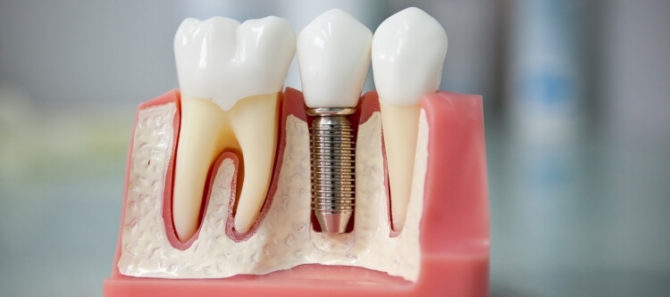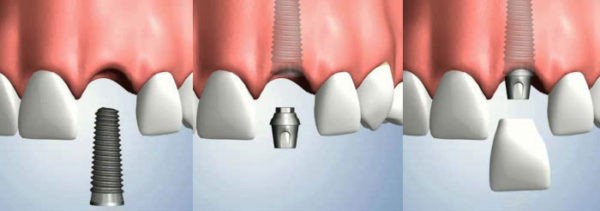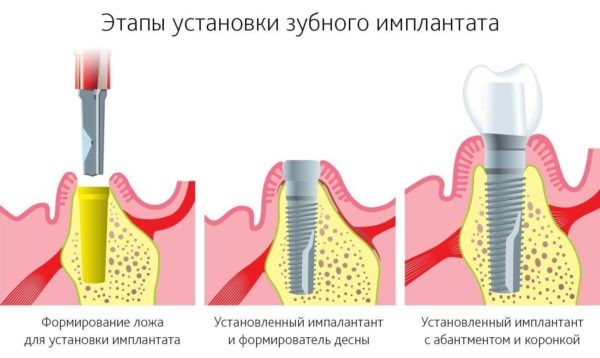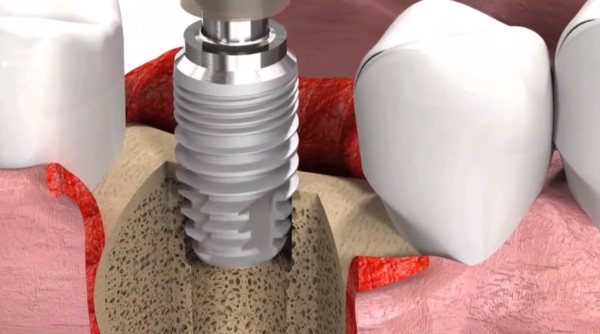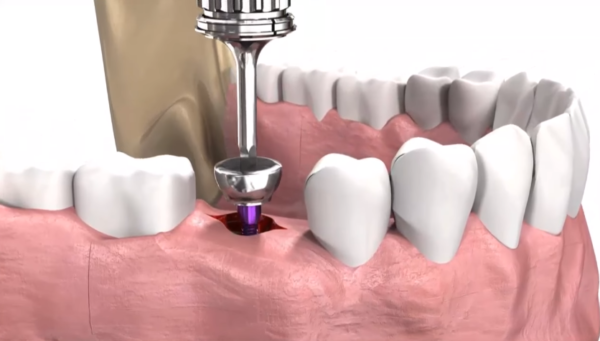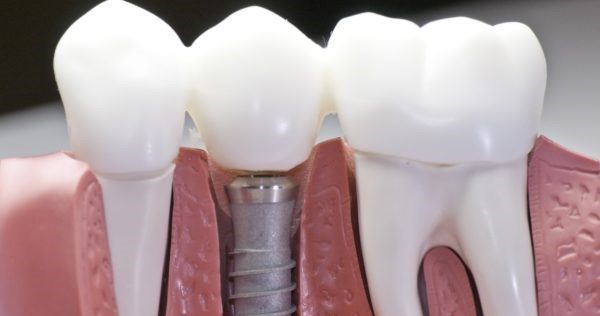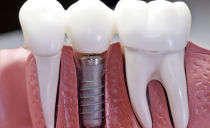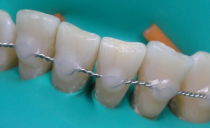Dental implants: types, cost and installation
Modern prosthetics methods allow the installation of artificial crowns, build them up with the help of synthetic materials, and make bridges. But only thanks to implantation, you can "equip" the mouth with teeth, in which there is not a single root. Moreover, in terms of functionality, implanted teeth will practically not differ from real ones, since they are implanted deep into the bone.
Content
The essence of the dental procedure
An implant (in English implant) is a design that imitates not only the upper part of the tooth, but also the root. Unlike the prosthesis, it cannot be removed and does not need to be cared for - only standard brushing and flossing. And most importantly, it looks aesthetically pleasing, since metal structures are embedded deep into the jaw and are not visible from under the snow-white crown.
A dental implant consists of three disassembled or cast parts. Among them:
- Supportthat mimics the root. Available in two types: in the form of a screw and a plate. In the first case, the element is screwed into the jaw tissue, in the second - it is clogged. In 98% of cases, titanium is used as the material for the manufacture of the support, since it is characterized by high strength, durability and, most importantly, good compatibility with the human body.
- Abutment - an intermediate link that connects the apex and the root support. It is made from the same material as the artificial root.
- Imitation of the external part of the tooth - crown. It is made of ceramics, zirconium and aluminum oxide, other noble and aesthetic metals.
The implant implantation technique was developed back in the 70s. Immediately after the discovery by scientists of a phenomenon such as osseointegration, the ability of a bone to grow around foreign bodies introduced into it and thereby tightly fix them in its cavity.
The essence of dental implants is simple. First, a structure resembling a root is implanted in the jaw. Over time, it grows together with bone tissue so firmly that it becomes "native". Immediately after this, an artificial crown is installed on the top of the simulation using a special adapter, which replaces the lost one.
The base of the dental implant remains in the jaw without damage for more than 40 years. A person can lead a normal lifestyle: eat solid food, click seeds, chop pistachios - an implanted prosthesis will not suffer. Only the crown is subject to periodic replacement, the service life of which depends on the material of manufacture and varies from 5 to 15 years.
Indications for tooth implantation
Implants can be implanted as desired. For example, instead of a bridge. After all, to install it, you need to make 3 artificial crowns and grind 2 real, and healthy ones, in order to fix the design on them. As a result, in order to restore one tooth, you have to sacrifice two others. And it is not a fact that they will not become inflamed after prosthetics and will not collapse completely.
Often implantation is resorted to forcefully. One of the situations is the absence of extreme teeth in the row or, as dentists say, an “end defect”. It is impossible to put a conventional prosthesis, since there is nothing to attach to it from behind.And the expensive clasp, which holds only one crown with the help of a special micro-lock, is not recommended to be installed in the area of chewing teeth, since it can not withstand the load.
In case of adentia - complete or partial absence of teeth - implantation is also indicated. It allows you to install the prosthesis in place of each lost unit. Or in selected areas to create a bridge under the bridge. The required number of "intermediate mounts" is determined by the doctor.
Contraindications
Implantation of an artificial root is a surgical procedure. Therefore, such a dental procedure has a number of contraindications. Some of them are strict:
- The age of the patient. It is forbidden to place teeth on implants for people under 20 years of age.
- Type 2 diabetes mellitus. This disease leads to a number of complications, among which slow healing of wounds, circulatory disorders and other negative consequences.
- A similar situation can occur with hepatitis, HIV, hemophilia, pathologies of the circulatory or nervous system.
Before the operation, patients pass tests so that the dentist excludes possible complications. Before receiving the necessary information, no doctor will begin prosthetics.
- Bruxism. This is gnashing of teeth. Typically, a defect appears in a dream, but can occur during the day. If a person with such a problem is given a dental implant, then with only one condition - if he will use protective mouthguards.
- Small bone volume. After tooth extraction, the jaw tissues begin to dry out, since they do not receive a load. The more time has passed, the higher the likelihood that the volume of the bone is not enough to implant the artificial root. There is a risk of hitting and damaging the mandibular nerve, and this is fraught with a number of unpleasant consequences: the patient may lose the sensitivity of the lips, chin, cheeks. Will not be able to control part of the face, salivation.
Implantation is less strictly contraindicated in the presence of dental caries, periodontal disease, and chronic diseases at the time of their exacerbation. As well as pregnant women and smokers.
Advantages and disadvantages
Pros in the prosthetics of the tooth on the implant mass:
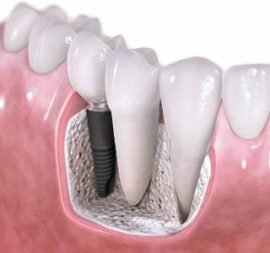 No need to grind adjacent, whole crowns, as when installing a bridge.
No need to grind adjacent, whole crowns, as when installing a bridge.- A more natural load on the bone, which is created through a deep and complete implantation. This is a significant advantage, since a change in load is fraught with deformation of the maxillofacial joint. As a result, bite may be affected.
- The teeth that are mounted on the implant are permanent. They do not need to be removed and “put in a glass”, like a removable denture. Special care is also not required. It is enough to follow standard oral hygiene.
- Externally, teeth mounted on implants do not differ from real ones, since metal structures are implanted deep into the bone and are not visible from the outside.
- The technique allows you to restore any number of teeth or make a solid foundation for the bridge of the entire jaw.
- The natural position of the tooth in the mouth, lack of discomfort.
- Complete restoration of chewing function. A person can eat hard, solid food and not worry about the safety of the prosthesis.
- A tooth implant is installed almost for life, only the upper crown is replaced.
Among the minuses, only the high cost of the procedure and low risk of rejection - only 2%.
Implant technology
Most often, the operation is carried out in two stages. During the first, a metal imitation of the root is placed in the bone tissue. A surgeon who specializes in implantology makes an incision on the mucous membrane and drills a hole in the jawbone, periodically cooling it with saline to prevent overheating. Then screw the dental implant into the hole made and sutures.
Some patients may need sinus lift - this is a bone extension in height.Typically, the need for an additional procedure arises in patients who have lost a tooth for a long time, and the bone volume during this time managed to greatly decrease. In this case, a person will need osteoplasty, and the terms of prosthetics will increase by 3-6 months.
The second stage of tooth implantation is the preparation of the gums. So that it has a natural contour under the crown, you need to screw a special nozzle into it - a shaper. After 2 weeks, you can install the abutment - the basis for the future crown, and make an impression on which it will be made. Mount the outer part either on the thread or on cement. The technique depends on the model chosen.
There is also a one-stage method of tooth prosthetics on an implant, in which a titanium base is implanted into the basal bone. It is located deeper than the spongy, has a denser texture and does not atrophy. The main advantage of the technology is that the entire structure is installed in just one week.
Preparation for surgery
The method of tooth implantation is not chosen by the patient, but by the doctor. Planning is divided into 2 stages - orthopedic and surgical. The first is carried out by a specialist in the field of orthopedic dentistry. He finds out how best to prosthetize a particular tooth or bridge. Typically, the technique is selected according to the following rules:
- If there is no one tooth, then 1 implant is implanted, and if three - 2.
- When it is necessary to install the prosthesis only from below or from above - from 2 to 4.
- With full adentia - from 8 to 10 on each jaw.
The second stage of planning is carried out by a surgeon in the field of implantology. He studies the anatomy of the jaw, the location of the nerves, the thickness of the bone at the prosthetics site. Such information is necessary for the selection of a titanium rod of the desired shape and length. Then the surgeon analyzes the data and decides how many stages and when it is better to carry out the operation.
To obtain comprehensive diagnostic information, a specialist can refer the patient to radiography, orthopantomography or tomography. The most effective method is the latter. It allows you to conduct a trial operation in the form of a computer simulation and work out all the possible errors in order to avoid them in practice.
Step operation
A patient who has been approved for tooth implantation arrives at the clinic on the appointed day. In the morning he does not eat or drink, and a week before the procedure he does not drink alcohol. It is also advisable to give up smoking.
The whole process of tooth implantation can be divided into four stages:
- preparation of the operated site;
- screwing in the support;
- fastening of the healing abutment;
- installation of an abutment and crown.
Reconstruction and installation of the support
Before starting the operation, the dentist surgeon cleans the root nest. It is necessary to remove all the remnants of nerve endings, pus and other secretions. At the same stage of implantation, treatment of damaged teeth and rehabilitation of the oral cavity is carried out.
The surgeon's further actions depend on whether the titanium base has a screw-like or lamellar shape. If the first, then the doctor makes an incision on the jaw, exposes the periosteum and cuts the thread with a drill. And then screw the imitation root. The procedure is carried out under anesthesia, so everything is not as scary as it sounds.
The second type of base is not screwed, but clogged into bone tissue. To install the plate, first you will also have to cut the jaw.
After the introduction of the artificial root, the surgeon sutures the incision and sends the patient home for healing and addiction. Usually from the next visit to the clinic takes place from three months to six months.
Shaper placement
When the base of the dental implant is completely fused with the bone tissue, the specialist will install a shaper designed to adapt the gums to the abutment and crown. To do this, the gum is cut again, since the structure must be immersed in the jaw tissue.
After adaptation, the former is removed, and a temporary abutment is placed in its place, which is necessary to take an impression from the jaw.Then it is removed, and the former is returned for the entire period during which the crown will be manufactured.
Installation of the external part
The final stage of implantation is the attachment of a tooth crown to the abutment. Fasten it with a screw or cement. The patient chooses the material of manufacture at his discretion.
If necessary, the upper part of the dental implant can be changed, while the root will remain in the jaw almost forever.
How much does a tooth implant cost?
Modern dentistry offers a wide selection of implants from different manufacturers, and they all differ in quality and price. Swiss, German and American products are famous for their highest durability. But the former are noticeably leading.
Swiss brands rely on quality materials. The service life, as well as the percentage of successful engraftment of their dental implants, is close to 99%. One of the most sought after brands - Nobel-biocare. The main advantage of its models is ultra-fast osseointegration, compatibility with all types of bone, a lifetime warranty and high stability. The cost of such implants, together with the installation in Moscow clinics, varies from 45 to 70 thousand rubles.
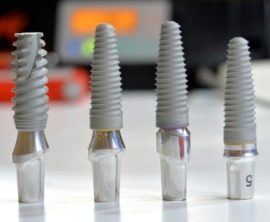 No less popular israeli brand Alfa bio tec. Under this name, 8 types of budgetary dental implants are produced. The purchase price of the most expensive is $ 120, the cheapest is $ 65. The cost of construction with installation in Moscow is from 23 thousand rubles. and higher.
No less popular israeli brand Alfa bio tec. Under this name, 8 types of budgetary dental implants are produced. The purchase price of the most expensive is $ 120, the cheapest is $ 65. The cost of construction with installation in Moscow is from 23 thousand rubles. and higher.
Swedish brand worth mentioning AstraTech. His models are created using the latest technology and are characterized by a high-quality connection between the abutment and the base. If around budget items bone decreases at a rate of 0.2 mm for each year after 5 years of use, AstraTech the indicator is several times smaller. The purchase and installation of the structure will cost more than 43 thousand rubles.
Any domestic implant, for example, Rusimplant or Conmet implantswill cost several times cheaper than imported. To purchase and implant one product, you need to spend less than 15 thousand rubles. But dentists recommend installing such implants only for the restoration of chewing teeth, since they differ markedly from aesthetics in relation to foreign ones.
The cost of dental implants depends on the popularity and conscientiousness of the manufacturer, the clinic's pricing policy, lead times and many other factors. But you don’t need to understand everything on your own: the dentist will definitely advise the client on the brands of products that will suit him, and on the cost.
The main thing is not to save on choosing a specialist. In the budget clinic there is neither the necessary equipment nor experience. Better to pay a little more than a few years to suffer because of complications. Remember, the installation of a tooth implant is a surgical operation, so you need to treat it responsibly.

